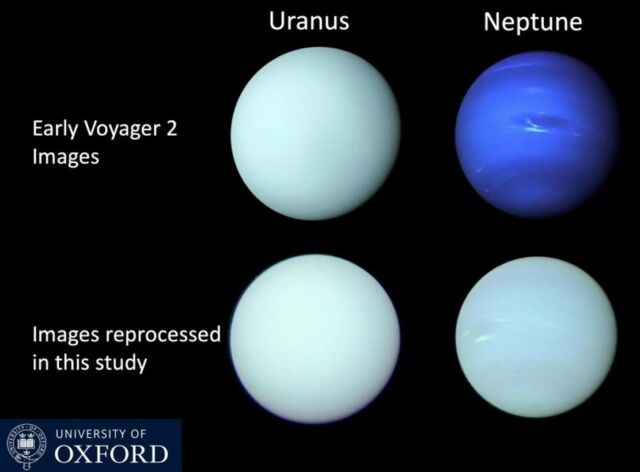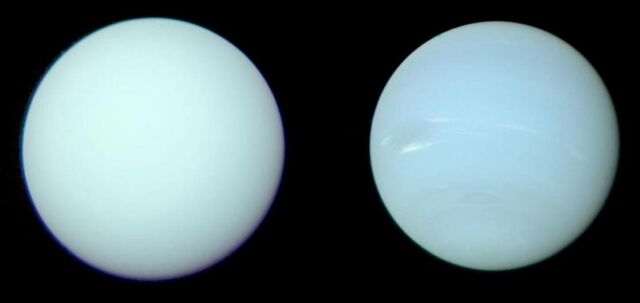 Credit Patrick Irwin/University of Oxford/NASA
Credit Patrick Irwin/University of Oxford/NASA
A new study has revealed that Neptune and Uranus the two ice giants planets, look like and are far closer in color than typically thought.
Research led by Professor Patrick Irwin from the University of Oxford has confirmed the accurate shades of Neptune and Uranus. Both planets exhibit a similar greenish-blue hue, dispelling the misconception that Neptune is deep azure and Uranus appears pale cyan.
Astronomers have long been aware that most modern images of these planets do not faithfully represent their true colors.
 Credit Patrick Irwin/University of Oxford/NASA
Credit Patrick Irwin/University of Oxford/NASA
The confusion originated from 20th-century images, including those from NASA’s Voyager 2 mission, the sole spacecraft to pass by these celestial bodies.
In a recent study, scientists analyzed data from the Hubble Space Telescope’s Space Telescope Imaging Spectrograph (STIS) and the Multi Unit Spectroscopic Explorer (MUSE) on the European Southern Observatory’s Very Large Telescope. These instruments capture each pixel as a continuous spectrum of colors, allowing for a clear determination of Uranus and Neptune’s true apparent colors.
By analyzing this data, the researchers corrected the composite color images from the Voyager 2 camera and the Hubble Space Telescope’s Wide Field Camera 3 (WFC3). The revised images unveiled that Uranus and Neptune share a similar greenish-blue shade.
The study also unraveled the mystery surrounding why Uranus’s color slightly changes during its 84-year orbit around the Sun.
Professor Irwin said:
“Although the familiar Voyager 2 images of Uranus were published in a form closer to ‘true’ color, those of Neptune was, in fact, stretched and enhanced, and therefore made artificially too blue.”
“Even though the artificially saturated color was known at the time amongst planetary scientists – and the images were released with captions explaining it – that distinction had become lost over time.”
“Applying our model to the original data, we have been able to reconstitute the most accurate representation yet of the color of both Neptune and Uranus.”
source Royal Astronomical Society





Leave A Comment